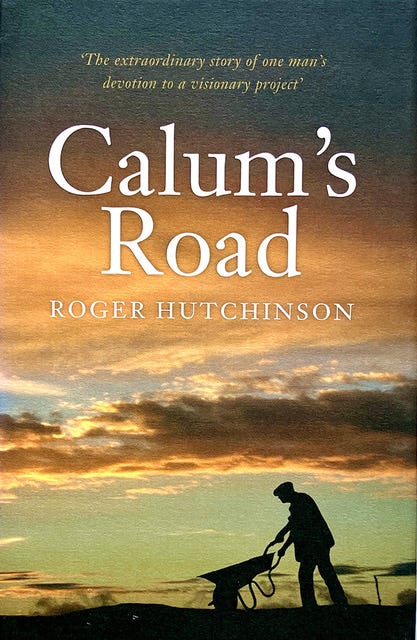Should you judge a cover by its book?
Designer Jim Hutcheson on the artistry and algorithms of book covers
I’ve been thinking about book covers because I have one to share - my first professionally produced book. This is the cover of Take me to the River, a compilation of our favourite writing about wild swimming, which I assembled with my friend Vicky Allan. Here is a ‘cover reveal’ video - turn on the sound to hear waves crashing.
I love this book - I can say that without bragging, as we didn’t write most of it, we just selected wonderful pieces from writers like Billy Connolly, David Sedaris, Joan Didion and Marilynne Robinson. We did put in a lot of time and thought though, so it is exciting to see it taking shape with this fun design by Emma Rogers.
The physical book is thriving despite its digital challenger
Take me to the River will be a printed hardback only, with no digital ebook version. (Because of the limits of the current copyright permissions, I can’t say for certain that there will be others. So reserve yours early!) A few years ago, the digital share of the market was growing - but it seems to have stabilised or even fallen to about 12% in the UK.
The book as a physical object is surviving better than was predicted. But now we have the alternative of reading on a screen, how a volume looks and feels is even more important.
Covers are your one chance to stand out from the crowd
A third are sold in shops (the rest online). It’s a tough market - wandering around some of Edinburgh’s many wonderful bookshops, it is daunting to see the piles of brilliant books competing for the buyer’s attention. Covers are the main chance an unknown author has to catch the eye. They can also give the bookseller a clue as to what genre - eg this book about the whisky business clearly doesn’t belong in the economics section.
I discussed book covers over coffee with Scottish cover designer Jim Hutcheson. Jim said that all you can really hope for from a cover is that it will entice the bookshop browser to pick it up from the table and have a look - after that you are on your own.
A stand-out talent spotted above a sofa
Pictures from Jim’s degree show were hanging in a furniture shop called Shapes in Jeffrey Street in Edinburgh when Stephanie Wolfe Murray, co-founder of Canongate Publishing and her friend Antonia Fraser came in to look around one day in 1975.
Stephanie contacted Jim, who went on to design many of Canongate’s iconic covers. When we met in the cafe-cum-bookshop of the National Library of Scotland, he was able to point to several of his. A colleague of Alistair Gray - they were both illustrators for the Molendinar Press and members of the Lost Poets - Hutcheson and Gray collaborated on turning Gray’s artwork into covers. Even with his first book, Lanark, Gray was thinking about how the spines of his books would look together on the shelf, and he relished the creative control Canongate gave him over the whole book - and disliked the first London edition of his work because he lost that.

One of Jim’s that you can see in most Scottish bookshops is the cover of a lovely book called ‘Calum’s Road’ by Roger Hutchinson about the man who built a road to Arnish, his township in Northern Raasay. It is a beautiful story and I wish someone would make a movie of it (there is a terrific play). That is actually Jim on the cover of the book pushing a wheelbarrow - he donned a bunnet and pushed the barrow across his backyard, captured by his daughter. He then overlaid the image on a photograph taken by Hebridean photographer Cailean Maclean, who lives on Skye. Cailean is a nephew of the great Gaelic poet Sorley, who was born on Raasay - listen to his poem Hallaig, about a deserted Rassay township. You might not know about the resonance of this cover when you see it but it is a powerful image - and it is the perfect cover for this book.
Back to the drawing board
Jim explained that back in the day, you had to start with actual artwork or photos that you had created. The work was made on a much bigger canvas and the design was then shrunk down. (Jim also did a lot of album cover artwork, which was a good size to work with.)
The design process has changed with the advent of computer-generated images. For example, the detective fiction table in your local bookshop is probably piled with volumes in a range of bilious shades, many featuring a shadowy figure in a raincoat, lurking. This figure will be from a stock library, perhaps via AI tools. Jim would have had to persuade a friend with the right kind of mac to walk away from the camera in an alleyway .
It is all a lot easier now - but in some ways, Jim feels, covers have become a bit too generic and bland. “I would like to see them taking a few more risks”. His example of a risky cover is a Canongate edition of Snowblind: A Brief Career in the Cocaine Trade by Robert Sebbag. Jamie Byng (who took over Canongate) got the British drug dealer Howard Marks to write a foreword and then he commissioned a cover from Damien Hirst made out of mirror glass, to be sold with an American Express bookmark and a real $100 bill. “They were meant to sell for £1000 each but the bookshops wouldn't touch them because the glass kept breaking.” Not one sold for the ticket price at the time - though it looks like Christie’s has sold one for $3000.
Looking around the bookshop, I kind of see Jim’s point. Stock photos and the art work generated from them are artfully vague. And the collective imagination tends to run in well-worn grooves. Perhaps now we are revelling anew in the physical presence of the book form, it is time to rediscover the handcrafted, bespoke cover, at least for bigger-selling authors.
Dressed to Impress
One book event still remains fabulously real-world based - the launch. Vicky’s swimming book launches usually start with a jubilant beachfront photo call with wild swimmers plunging into the surf. As a larger lady, I’m reluctant to pose in my skimpies - I wouldn’t say no to a bit of AI doctoring on that front frankly - so I have suggested we dress up as a characters who appear in the book, some of whom could definitely wear floor-length robes.
I’m thinking Poseidon or Amphitrite, the sea-god’s wife. I already bought a plastic trident which I spotted in a charity shop, only slightly damaged, and a steal at £2.50. I carried it proudly home across the Meadows, attracting surprisingly little attention. It’s not easy to stand out from the crowd. It obviously takes more than a wonky weapon of the gods, at least in Edinburgh, where we are very accustomed to creatives in fancy dress.
Take me to the River is available now to pre-order from your preferred bookseller







Congratulations on the book, the cover is lovely!
Congratulations on the book ! Cover is great.